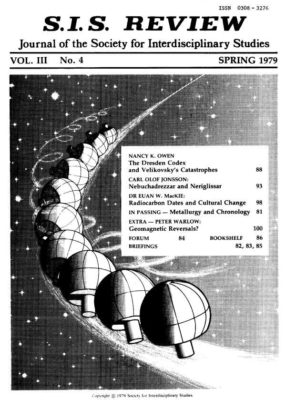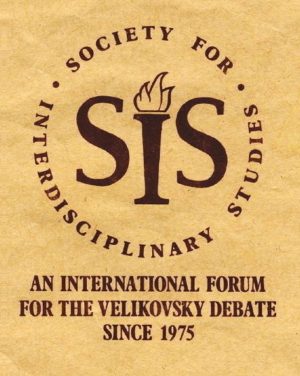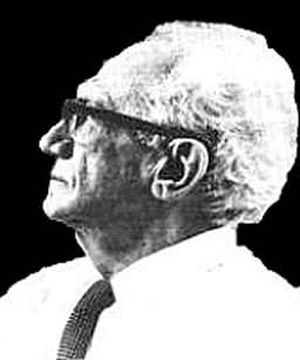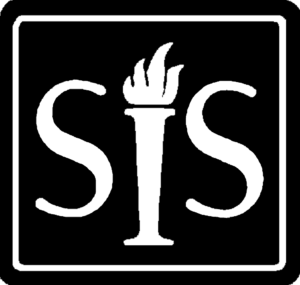The Society for Interdisciplinary Studies (SIS) is a membership-based organization “formed in 1974 in response to the growing interest in the works of modern catastrophists, notably the highly controversial Dr Immanuel Velikovsky“.[1]Society for Interdisciplinary Studies, Chronology and Catastrophism Workshop, 2007:2 (back cover) Based in the United Kingdom, it publishes the journals, Chronology & Catastrophism Review, a more informal publication Chronology & Catastrophism Workshop, and sponsors occasional conferences. It is a non-profit organization that is registered as an educational charity.[2]Under the UK Charity Act, it is registered Charity No: 286264 Henry Bauer notes that “Some groups within the British Society for Interdisciplinary Studies, by contrast, have proposed major revisions to Velikovsky’s revision of ancient chronology”.[3]Henry H. Bauer, “The Velikovsky Affair”, La Récherche 205 (December, 1988), pp. 1448-145. Reprinted in Aeon II:6 (1991)
“… it was made clear right from the start that the Society had been formed to examine the ideas of Velikovsky and other catastrophists, not to promote any particular point of view”.[4]Trevor Palmer, Perilous Planet Earth: Catastrophes and Catastrophism Through the Ages, Ch.12 Heretical Catastrophists”, Publ. Cambridge University Press, 2003, ISBN 0521819288, 9780521819282. page 118
Astronomer David Morrison writes that:
“the Society for Interdisciplinary Studies (SIS), [ is] a British group that espouses a skeptical philosophy but includes many defenders of Velikovskian ideas”[5]David Morrison, “Is the Sky Falling?“, Skeptical Inquirer, Volume 21.3, May / June 1997
The SIS is run by an elected Council that includes a Chairman (with a five year tenure), Secretary and Treasurer, and nine other officers. It has been noted that the Society’s “membership is not large”.[6]Henry H. Bauer, Beyond Velikovsky: The History of a Public Controversy, Publ. 1999 University of Illinois Press, 354 pages,ISBN 0252068459
Prof. Trevor Palmer dedicates his book, Perious Planet Earth (Cambridge University Press, 2003): “to the members of the Society for Interdisciplinary Studies and the Cambridge Conference Network”.[7]T. Palmer, Perilous Planet Earth: Catastrophes and Catastrophism through the Ages, Cambridge University Press, 2003, page v.
Publications
Chronology & Catastrophism Review (C&C Review)

Following two publications called Newsletter 1 (in April 1975), and Newsletter 2 (in September 1975), the first issue of SIS Review Vol. I, issue 1 appeared in January 1976. Called SIS Review until 1996, C&C Review is “the most successful Velikovskian journal”[8]Michael Gordin, The Pseudoscience Wars: Immanuel Velikovsky and the Birth Of The Modern Fringe, publ. University of Chicago Press; Reprint edition (27 Aug. 2013), ISBN-10 022610172X, ISBN-13 978-0226101729 (304 pages) page 197, a “revisionist journal”[9]Michael Gordin, The Pseudoscience Wars: Immanuel Velikovsky and the Birth Of The Modern Fringe, publ. University of Chicago Press; Reprint edition (27 Aug. 2013), ISBN-10 022610172X, ISBN-13 978-0226101729 (304 pages) page 188, and the flagship publication of the Society is published annually, though it has appeared as frequently as four times a year. It describes itself as:
“.. a forum for the continuing debate on the subjects of revised chronologies (of Immanuel Velikovsky and later revisionists), biblical studies, mythology, geology, catastrophism, evolution, archaeology, ancient history, cosmology, physics, astronomy, palaeontology and other disciplines. It also provides a forum for independent and critical assessment in the field of cosmic global catastrophism of the kind described by Velikovsky, plus the theories of more recent catastrophists. Topics covered include the role of electromagnetism in cosmology, space probe findings about comets and planets, modern scientific dating methods and evidence for cosmic catastrophes during historical times.”[10]Chronology & Catastrophism Workshop, 2007:2 (inside back cover)
Velikovsky himself took “a dim view of its revisionist attitude”.[11]Frederic B. Jueneman, “Velikovsky: A Personal Chronological Perspective of His Final Years”, Aeon III:1 (Nov 1992) Alfred de Grazia recalls that “the first issue of their Review, later to be attractively printed, was in mimeography and, at that, barely readable, but its contents were of excellent quality”.[12]Alfred de Grazia, “Cosmic Heretics”, Aeon II:6 (1991) (excerpted from A. de Grazia’s Cosmic Heretics) full text
Chronology & Catastrophism Workshop (C&C Workshop)
The first issue of S.I.S. Workshop No. 1 appeared in March 1978. Called SIS Workshop until 1996, C&C Workshop is a more informal publication that appears three times a year. It is dedicated to the memory and spirit of Derek Shelley-Pearce, its first editor, who died in 1992. Workshop did not appear between 1996 and 2002.
SIS Internet Digest
14 issues of SIS Internet Digest appeared between 1996 and 2002, as a means of communicating Internet-sourced information to members.
Conferences and meetings

At the Society’s Annual General Meeting, the SIS organizes a free talk to members. And on a less regular basis, the SIS organizes an international public conference, that have included:
- 1978: Ages in Chaos? How valid are Velikovsky’s views on Ancient History?
- 1993: Evidence that the Earth has suffered Catastrophes of Cosmic Origin in Historical Times[13]”The Society for Interdisciplinary Studies (SIS)”, Planetary and Space Science, Volume 46, Issues 2–3, February–March 1998, Page 341 (#)
- 1995: Velikovsky’s 100th Birthday Memorial Weekend.
- 1997: Natural Catastrophes during Bronze Age Civilisations: Archaeological, Geological and Astronomical Perspectives.[14]Proceedings published in British Archaeological Reports S728, 1998, “Natural Catastrophes During Bronze Age Civilisations: Archaeological, geological, astronomical and cultural perspectives”, edited by Benny J. Peiser, Trevor Palmer and Mark E. Bailey. ISBN 0 86054 916 X., pp.252. 39 photos, 46 figures, 13 tables, Publ. Archaeopress, Oxford. (Second SIS Cambridge Conference)[15]Trevor Palmer, Perilous Planet Earth: Catastrophes and Catastrophism Through the Ages, Ch.29 “Natural Catastrophes and the rise and fall of civilisations”, Publ. Cambridge University Press, 2003, ISBN 0521819288, 9780521819282. page 346 including contributions from: Benny J. Peiser, Trevor Palmer, Mark E. Bailey, Robert A. J. Matthews, Bill Napier, Gerrit Verschuur, Bruce Masse, Marie-Agnès Courty, M. G. L. Baillie, Amos Nur, Lars G. Franzén and Thomas B. Larsson, Bas van Geel, Oleg M. Raspopov, Johannes van der Plicht, Hans Renssen, Euan MacKie, Gunnar Heinsohn, David W. Pankenier, William Mullen, Irving Wolfe, and S. V. M. Clube.
- 1999: SIS Silver Jubilee Event, Incorporating a conference on Chronology & Catastrophism.
- 2002: Ages Still in Chaos: An investigation into progress made in the revision of ancient history since 1952, and possible ways ahead
- 2007: Cosmic Catastrophes – Asteroids, Comets and Planets: Possibilities and Probabilities in the Light of Today’s Findings and the Testimony of Ancient Man
Founding and constitution
The Times newspaper (London) writes:
A British Society for Interdisciplinary Studies was founded in 1974 with the aim of encouraging a rational approach to Velikovsky’s theories.”[16]Obituary: Dr Immanuel Velikovsky, The Times, November 20, 1979
Then:
“In Britain, the Glasgow University archaelogist Euan MacKie .. went on to become a founding member of the Society for Interdisciplinary Studies (SIS), an organisation designed to provide a forum for open-minded discussions of all aspects of catastrophism and chronology.”[17]Ibid. palmer 2003
An SIS-sponsored conference notes:
“The SIS was formed in 1975 to provide a forum for the discussion of all aspects of catastrophism and chronology ..
.. in 1973, archaeologist Euan MacKie wrote in New Scientist that, no matter whether Velikovsky was right or wrong, he had formulated hypotheses which should be tested in the normal way 17. In the same year, he suggested in Pensée that radiocarbon dating might provide the evidence for a test of Velikovsky’s theories of global catastrophes and chronological revisions 18.
A year later, on the 5th November 1974, MacKie discussed related matters with Harold Tresman, Brian Moore and Martin Sieff over a meal at the Regent Palace Hotel in Picadilly and, as a direct consequence, the SIS came into being”.[18]Natural Catastrophes During Bronze Age Civilisations: Archaeological, geological, astronomical and cultural perspectives, edited by Benny J. Peiser, Trevor Palmer, Mark E. Bailey, BAR International Series 728, 1988. ISBN 0 86054 916 X. (Full text) Inline references 17 MacKie, E.W., 1973, A challenge to the integrity of science, New Scientist 11 January, 76-77. 18 MacKie, E.W., 1973, A quantitative test for catastrophic theories, Pensée IVR III(Winter), 6-9.
Professor of Social Theory, Alfred de Grazia noted that:[19]Alfred de Grazia, Cosmic Heretics (1984), “Ch. 5: The British Connection”, Metron Publ., Chapter 4. ISBN: 0940268086
“The early 1970’s witnessed the founding in England of the Society for Interdisciplinary Studies (SIS), conceived by a gang of four, and on a Halloween night. The first issue of their Review, later to be attractively printed, was in mimeography and, at that, barely readable, but its contents were of excellent quality. The founders, and those who signed up, many of them American, settled into a flexible oligarchy. .. The Constitution of the Society adopted in 1978 declared as its principal objectives:
- to promote a multi-disciplinary approach to scientific and scholarly problems and in particular to promote the active consideration by scientists, scholars, and students of alternatives to the theory of uniformity in astronomy and earth history:
- to promote a better understanding of the nature of the earth, the solar system and human history, through the combined use of historical and contemporary evidence of all kinds, and to encourage a continuous reassessment of the validity of the basic assumptions of the discipline concerned by testing these against evidence;
- to promote better co-operation between workers in specialized fields of learning in the belief that isolated study is sterile;
- to foster research among scientists and scholars towards achieving these aims.
Henry Bauer notes:
“An English group interested in catastrophism in general and Velikovsky in particular is the Society for Interdisciplinary Studies; the membership is not large, but its S.I.S. Review gained wider circulation through the services of the Research Communication Network and mentions Kronos.”[20]Henry H. Bauer, Beyond Velikovsky: The History of a Public Controversy, Publ. 1999 University of Illinois Press, 354 pages, ISBN 0252068459. (page 68)
Harry Collins et al write:
The Society for Interdisciplinary Studies was founded in 1974, another organisation inspired by Immanuel Velikovsky. The SIS straddles fringe archaeology and fringe physics. Presenters at their meetings discuss catastrophist interpretations of pre-history alongside ideas such as the Electric Universe. Evidence of ancient catastrophes play a central role in their work and they claim that ‘[many] great discoveries and insights are made by intuitive non-scientists’. The analysis of this group in terms of characteristics is similar to that of The Thunderbolts Project.[21]Harry Collins, Andrew Bartlett and Luis Reyes-Galindo, “Demarcating Fringe Science for Policy“, Perspectives on Science”, Volume 25, Issue 4, July-August 2017, p.411-438 (full text)
See also
External links
- Society for Interdisciplinary Studies official Web site
References
| ↑1 | Society for Interdisciplinary Studies, Chronology and Catastrophism Workshop, 2007:2 (back cover) |
|---|---|
| ↑2 | Under the UK Charity Act, it is registered Charity No: 286264 |
| ↑3 | Henry H. Bauer, “The Velikovsky Affair”, La Récherche 205 (December, 1988), pp. 1448-145. Reprinted in Aeon II:6 (1991) |
| ↑4 | Trevor Palmer, Perilous Planet Earth: Catastrophes and Catastrophism Through the Ages, Ch.12 Heretical Catastrophists”, Publ. Cambridge University Press, 2003, ISBN 0521819288, 9780521819282. page 118 |
| ↑5 | David Morrison, “Is the Sky Falling?“, Skeptical Inquirer, Volume 21.3, May / June 1997 |
| ↑6 | Henry H. Bauer, Beyond Velikovsky: The History of a Public Controversy, Publ. 1999 University of Illinois Press, 354 pages,ISBN 0252068459 |
| ↑7 | T. Palmer, Perilous Planet Earth: Catastrophes and Catastrophism through the Ages, Cambridge University Press, 2003, page v. |
| ↑8 | Michael Gordin, The Pseudoscience Wars: Immanuel Velikovsky and the Birth Of The Modern Fringe, publ. University of Chicago Press; Reprint edition (27 Aug. 2013), ISBN-10 022610172X, ISBN-13 978-0226101729 (304 pages) page 197 |
| ↑9 | Michael Gordin, The Pseudoscience Wars: Immanuel Velikovsky and the Birth Of The Modern Fringe, publ. University of Chicago Press; Reprint edition (27 Aug. 2013), ISBN-10 022610172X, ISBN-13 978-0226101729 (304 pages) page 188 |
| ↑10 | Chronology & Catastrophism Workshop, 2007:2 (inside back cover) |
| ↑11 | Frederic B. Jueneman, “Velikovsky: A Personal Chronological Perspective of His Final Years”, Aeon III:1 (Nov 1992) |
| ↑12 | Alfred de Grazia, “Cosmic Heretics”, Aeon II:6 (1991) (excerpted from A. de Grazia’s Cosmic Heretics) full text |
| ↑13 | ”The Society for Interdisciplinary Studies (SIS)”, Planetary and Space Science, Volume 46, Issues 2–3, February–March 1998, Page 341 (#) |
| ↑14 | Proceedings published in British Archaeological Reports S728, 1998, “Natural Catastrophes During Bronze Age Civilisations: Archaeological, geological, astronomical and cultural perspectives”, edited by Benny J. Peiser, Trevor Palmer and Mark E. Bailey. ISBN 0 86054 916 X., pp.252. 39 photos, 46 figures, 13 tables, Publ. Archaeopress, Oxford. |
| ↑15 | Trevor Palmer, Perilous Planet Earth: Catastrophes and Catastrophism Through the Ages, Ch.29 “Natural Catastrophes and the rise and fall of civilisations”, Publ. Cambridge University Press, 2003, ISBN 0521819288, 9780521819282. page 346 |
| ↑16 | Obituary: Dr Immanuel Velikovsky, The Times, November 20, 1979 |
| ↑17 | Ibid. palmer 2003 |
| ↑18 | Natural Catastrophes During Bronze Age Civilisations: Archaeological, geological, astronomical and cultural perspectives, edited by Benny J. Peiser, Trevor Palmer, Mark E. Bailey, BAR International Series 728, 1988. ISBN 0 86054 916 X. (Full text) Inline references 17 MacKie, E.W., 1973, A challenge to the integrity of science, New Scientist 11 January, 76-77. 18 MacKie, E.W., 1973, A quantitative test for catastrophic theories, Pensée IVR III(Winter), 6-9. |
| ↑19 | Alfred de Grazia, Cosmic Heretics (1984), “Ch. 5: The British Connection”, Metron Publ., Chapter 4. ISBN: 0940268086 |
| ↑20 | Henry H. Bauer, Beyond Velikovsky: The History of a Public Controversy, Publ. 1999 University of Illinois Press, 354 pages, ISBN 0252068459. (page 68) |
| ↑21 | Harry Collins, Andrew Bartlett and Luis Reyes-Galindo, “Demarcating Fringe Science for Policy“, Perspectives on Science”, Volume 25, Issue 4, July-August 2017, p.411-438 (full text) |

